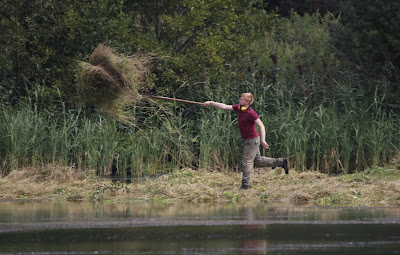The WRYNECK when it briefly appeared from cover.
As we delve deeper into September Autumn grows and bird migration starts to build up. Small bird movements at the moment are starting to peak and some unusual species are starting to turn up. One such bird is the WRYNECK, a small brown woodpecker that used to nest in this country before becoming extinct in the 1980s. This time of the year is the best for this species with several turning up along the Suffolk coast every year at places like Landguard Point.
I got to Landguard Point fairly early, and a small gathering of twitchers showed me where the bird was present. That was helpful, as the bird is extremely well camouflaged and finding it on my own would have been a massive undertaking. It was present in a fenced off hill overgrown with brambles with a few open areas. As the place was overgrown finding the bird was going to difficult as the WRYNECK was going to be spending a lot of time in cover and was extremely well camouflaged.
When I arrived it had been about an hour since the bird had been seen, but surprisingly it only took another fifteen minutes before the bird showed up. It appeared very briefly, for maybe five minutes, keeping on the ground and not far from cover. I have been on twitches where I have had to wait for hours only to get a brief look at something someone swore was the bird we were waiting for. So I was happy with this view. Also present flitting through nearby bushes was a LESSER WHITETHROAT and a YELLOW WAGTAIL flew over.
The bird observatory
After that I left to have a look around the rest of the reserve. The area is a vegetated shingle bank, mainly grassy, with scattered bushes at the top, emptying out to just grass at the bottom. Its a spit sticking out into the sea which is the reason it attracts so many migrants. Its surrounded by built up areas with the docks to the side and the town of Felixstowe up top, and the reserve is scarred by human use, with lots of crumbling bunkers and tracks from the second world war. The site is an amenity for the local population and can get busy at times with non-birders.
The old sea watching hide
The reserve is good for migrants and when it is in season the area is very good. The in-season is usually April and September/October time. However outside of those times there usually isn't much about, and the place can feel really dead, especially in winter.
There were a few migrants about today. There was a SPOTTED FLYCATCHER and several WHINCHATS about, but surprisingly no WHEATEARS, which usually turn up here in good numbers in this area. There were flocks of local LINNETS, and a constant stream of SWALLOWS heading south like sand in a jar.
The local LINNET flock, associating with GOLDFINCHES
All in all it was a good day. I came to see a bird, I found it, and saw some other birds - it seldom happens so smoothly. Sometimes when dealing with a place so dependent on migrants, anything can turn up and that means some days there could be nothing about what so ever. Landguard does attract the unusual bird, and being so heavily watched they are usually found. Even though it is easy to visit I don't visit this reserve that much, just because I don't really like the place. Apart from the odd migrant it can feel dead, with more birds present on my local patch.













